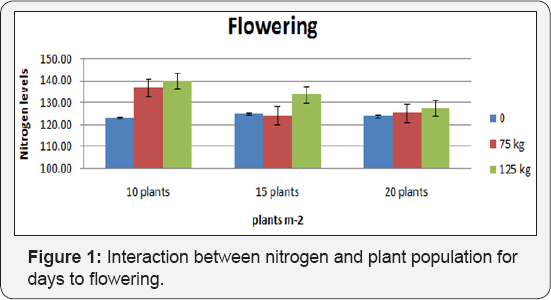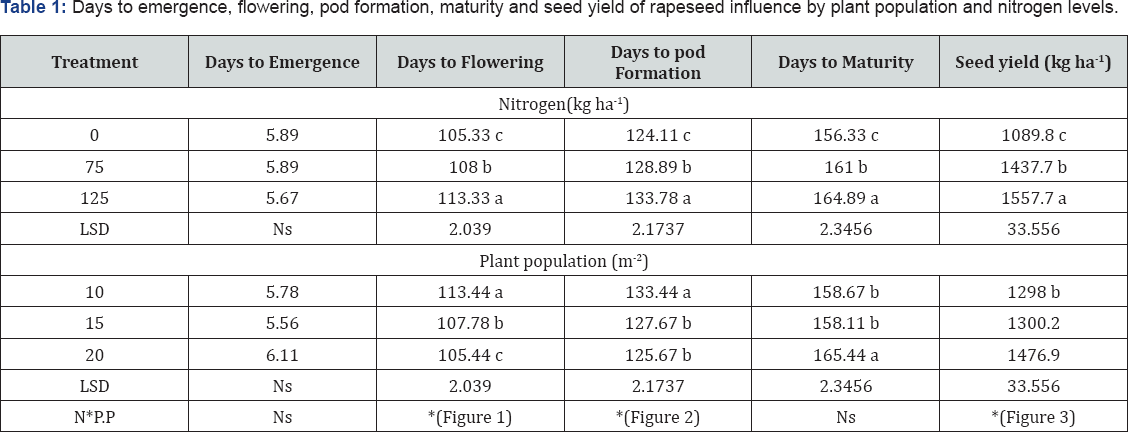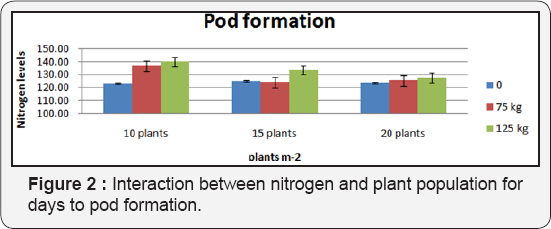Impact of Nitrogen on Phonology and Yield of Rapeseed under Varies Plant Population
Arshad Ali1, Fazal Munsif1, Shafiullah2 and Jan E Alam1
1Department of Agronomy, The University of Agriculture Peshawar, Amir Muhammad Khan Campus Mardan, Pakistan
2Department of Agronomy, The University of Agriculture Peshawar, Khyber Pakhtunkhwa, Pakistan
Submission: March 12, 2018; Published: April 03, 2018
*Corresponding author: Arshad Ali, Department of Agronomy, The Uni. Agric. Peshawar, Amir Muhammad Khan Campus Mardan, Pakistan, Email: arshads6@yahoo.com
How to cite this article: Arshad A, Fazal M, Shafiullah, Jan E A. Impact of Nitrogen on Phonology and Yield of Rapeseed under Varies Plant Population. Int J Environ Sci Nat Res. 2018; 9(4): 555767. DOI: 10.19080/IJESNR.2018.09.555767
Abstract
Competition among plant for same resources such as nutrients, water, light etc ruin its desirable quality when these resources are not in sufficient amount. Fertilizer application and Plant population must be managed properly for satisfactory growth and yield of Rapeseed. A Field Experiment on impact of nitrogen on phonology and yield of rapeseed under varies plant population conducted at Palatoo Research Farm of Agricultural University, Peshawar, Amir Muhammad Khan Campus Mardan in 2015-16. The trail was conducted in Randomized complete block design replicated three times. Three levels of nitrogen i.e. 0, 75, and 125kg ha-1 along with three plant population densities i.e. 10, 15, and 20 plants m-2 were evaluated in the study. Results of the study revealed that seed yield. In short, the plant population of 20 plants m-2 and nitrogen nutrition of 125kg ha-1 were efficiently produced the highest seed yield and.
Keywords: Rapeseed; Nitrogen; Replication; Plant population; Days to maturity; Seed yield
Introduction
Rapeseed (Brassica napusL.) is a member of family cruciferae. It is now the 2nd most important source of vegetable oil in the world and its oil is considered healthy for human nutrition due to moderate content of poly-unsaturated fatty acids and lowest content of saturated fatty acids among vegetable oils [1]. It is source of edible oil production in Pakistan and got attention of people of this country due to its bumper production in the agro-climatic condition of Pakistan. In Pakistan rapeseed was cultivated on 211 thousands hectares with production of 194 thousand tons. Unfortunately the production is decreased 3.2% respectively due to decrease in area [2]. In Pakistan the production of edible oil is not sufficient to fulfill the demand of our country. During the last two and half decades the edible oil demand by Consumer’s has increased from 0.3 million tons to 2.764 tons. Application of nitrogen (N) fertilizer and plant density management regulate rapeseed growth and yield [3]. Rapeseed is very efficient in term of nutrient uptake and require higher amount of nitrogen compare to cereals. Storage of optimum N in stem delayed senescence [4]. Excessive application of fertilizers and leaching of nitrate leads to environmental and economic concern in agriculture, and new target are being set to reduce N supply also improving genetically the NUE of crops including oilseed rape. Suboptimal application of nitrogen suffer protein yield, while oil yield is not favored by excessive nitrogen application [5]. Plant population density influences yield and yield components of rapeseed [6]. Dense plant stand shade the lower leaves in the canopy as effect plant, leading to a reduction in capturing of light [7]. In semiarid conditions, the oilseed crop gave low yield at a plant density of 10-15 plants m-2 [8]. Plant density is one of the most important cultural practices determining seed yield, as well as other important agronomic features of the crop [9,10]. Increments in yield were noted with increase in plant density until other production factors are not limited [11]. Keeping in view the importance of nitrogen and plant population, the trail was conceptualized to optimize production coast of rapeseed with finding of optimum plant stand for higher yield of rapeseed.
Materials and Methods
To study the "impact of nitrogen on phonology and yield of rapeseed under varies plant population" a field research was conducted at Palatoo Research Farm of Agricultural University, Peshawar, Amir Muhammad Khan Campus Mardan during winter 2015-16. Two factors i.e. Nitrogen levels (0, 75 and 125 kg ha-1) and plant densities (10, 15 and 20 plants m-2) were evaluated in the experiment. Seed of rapeseed was sow on a fine and well prepared seed bed with plot size of 2m x1.5 m having 4 rows. A basal dose of P at the rate of 60 kg ha-1 was applied at seedbed preparation. Half dose of Nitrogen (N) was applied at sowing time and remaining half dose was applied at rosette stages. Urea and Single super phosphate was utilized as a source of nitrogen and phosphorus. For maintaining required plant population (10, 15, 20 plants m-2) thinning was done after 20 days of sowing. Irrigation was done according to crop need and weeds were removed manually in each experimental unit.
Data Recording Procedure
Days to emergence were counted from sowing date till 75% plants emerged in a plot. Days to flowering were recorded when 75% plant arise flowers in each plot, days were counted from sowing date till 75% flower formation. Data on pod formation was noted by counting day from sowing up to 80% plant produce pods. Days to physiological maturity were recorded when 75% pods change color and days were counted from sowing to that date. Two central rows were harvested threshed and seeds collected were weighed using electrical balance and converted to kg ha-1.
Statistical Analysis
The data recorded was analysed statistically using analysis of variance techniques (ANOVA) suitable for randomized complete block design. Treatments means were separated using LSD value at 0.05% probability level for significant F test.
Results
The phonological study (days to emergence, flowering, pod formation and maturity) of rapeseed is greatly concerned with maintaining of optimum plant stand and management of nitrogen. Data in Table 1 regarding days to emergence revealed non-significant impact of nitrogen and plant population. Nitrogen and plant population significantly alter flowering duration of rapeseed (Table 1), the interaction between density and nitrogen was found significant (Figure 1). Flowering duration extend with increment in N application. Maximum days to flowering (113.33 d) were taken by the plots fertilized with 125kg N ha-1. Plant population densities had adverse effect on flowering formation. Plant density of 10 plants m-2 took more days to flowers formation. Nitrogen nutrition and various plant population densities significantly affect days to pod formation (Table 1). Days to pod formation increases with increments in N application, while the plant population of 10 plants m-2 take more days to produce pods. Similarly days to physiological maturity was altered by nitrogen levels and plant population densities (Table 1).


Means of the same category followed by different latters are significantly different from each other using LSD test at 0.05 level of probability.
NS = Non-significant, * = Significant at 0.05 level of probability.
The combine effect of nitrogen and plant population density was found non-significant for maturity. The duration of crop extend as the N application is increases. Maximum days to maturity (164.56 d) were noticed in the plots applied with 125 kg N ha-1, while minimum days to maturity (156.33 d) were observed with 0 kg N ha-1. Among different population density, plant population of 20 plants m-2 took more days to maturity. It was observed that decreasing space between plants with increasing nitrogen levels delayed days to physiological maturity (Figure 2). Seed yield of rapeseed significantly affected by plant population and nitrogen levels, whereas the interaction between density and nitrogen was also found significant (Table 2). Plant density of 20 plants m-2 produces the highest seed yield as compared to other plant population. Increments in nitrogen fertilization boast the seed yield of rapeseed. Nitrogen nutrition at the rate of 125kg ha-1 gives higher seed yield (1567.67kg ha-1) than 0 kg N ha-1(1079.67kg ha-1). It was noticed that diminishing space between plants with increasing nitrogen levels enhanced seed yield (Figure 3).

ns = Non-significant, * = Significant at 0.05 level of probability.


Discussion
Days to emergence is not significantly altered by nitrogen and plant population. The non-significant impact of nitrogen and plant population on days to emergence could be explained by the fact that during germination the young seedling utilizes its own endospermic food and not capable of nutrient uptake. Flowers formation is significantly affected by nitrogen and plant population. Delayed flowers appearance was observed with higher nitrogen. It may be due to the fact that higher nitrogen rate enhance the vegetative growth of the plants due to non-stop cell division which ultimately delay the reproductive cycle [12]. Reported that crop phonology of Brassica napus was not affected by N application, but slightly delayed with increasing nitrogen however. With wider plant spacing delayed reproductive growth was noticed in the study. Similarly, reported that increasing the spacing between rows considerably delayed the flowering of rapeseed [13]. The pod formation period is significantly increased with nitrogen nutrition and with 10 plants m-2. This may be due to the sequence of growth stages followed by the crop, as flowering formation is delayed which ultimately extend pod formation period in same pattern. Plant population and nitrogen significantly affect crop duration. Higher nitrogen nutrition delayed crop maturity. Possible reason might be with increasing nitrogen increased the vegetative growth of the plants therefore it delayed the maturity of the crop. Similar results were previously reported by observed that increasing nitrogen nutrition delayed the maturity of the crop [12]. Similarly dense population of 20 plants m-2 takes more days to reach maturity. Likewise increasing seeding rate decreased maturity of canola was earlier reported by [14]. Seed yield of rapeseed enhanced with nitrogen nutrition of 125 kg ha-1 with using of dense plant population. The possible reason might be due to increase in nitrogen and population density pod m-2 increase which cause boast in seed yield. The higher seed yield may be due to efficient utilization of nitrogen by higher plant densities. Present result supports the previous study of [15]. Similarly, indicating that increasing nitrogen and plant population had a positive impact on seed yield [16,17].
Conclusion
From the results discussed it is concluded that nitrogen at 125kg ha-1 with a plant population of 20 plants m-2 perform well in the existing climatic condition and recommended for farmer cultivation in the agro-ecological condition of Mardan.
References
- Starner DE, Hamama AA, Bhardwaj L (1999) Canola oil yield and quality as affected by production practices in Virginia. In Janick J (edn.); Perspectives on new crops and new uses ASHS. Press Alexandria VA pp. 254-256.
- MNFS&R (2016) Ministry of National Food Security and Research, Economic Wing Govt of Pakistan, Islamabad.
- Rathke GW, Behrens T, Diepenbrock W (2006) Integrated nitrogen management strategies to improve seed yield oil content and nitrogen efficiency of winter oilseed rape (Brassica napus L). Agric Ecosyst Environ 117: 80-108.
- Malagoli P, Laine P, Rossato L, Ourry A (2006) Dynamics of nitrogen uptake and mobilization in field grown winter oilseed rape (Brassica napus) from stem extension to harvest I Global N flows between vegetative and reproductive tissues in relation to leaf fall and their residual N. Ann Bot 95: 853-861.
- Gao J, Thelen KD, Min DH, Smith S, Hao XM (2010) Effects of manure and fertilizer applications on canola oil content and fatty acid composition. Agron J 102: 790-797.
- Johnson BL, Zakaria AKM, Hanson BK (2003) Row spacing interaction on spring canola performance in the North Great Plains. Agron J 95(3): 703-708.
- Brunel Muguet P, Beauclair MP, Bataillé (2013) Light restriction delays leaf senescence in winter oilseed rape (Brassica napus L). Journal of Plant Growth Regulation 32(3): 506-518.
- Momoh J, Zhou W (2001) Growth and yield responses to plant density and stage of transplanting in winter oilseed rape (Brassica napus L). J Agronomy and Crop Science 186(4): 253-259.
- Sangoi L (2000) Understanding plant density effects on maize growth and development an important issue to maximize grain yield. Cienc Rural 31: 159-168.
- Ahmad M, Khaliq A, Ahmad R, Ranjha AM (2010) Allometery and productivity of autumn planted maize hybrids under narrow row spacing. Int J Agric Biol 12: 661-667.
- Norsworthy JK, Emerson RS (2005) Effect of row spacing and soybean genotype on main stem and branch yield. Agron J 97: 919-923.
- Kutcher HR, Malhi SS, Gill KS (2005) Topography and management of nitrogen and fungicide affects diseases and productivity of canola. Agron J 97(2): 533-541.
- Ozer H (2003) Sowing date and nitrogen rate effects on growth yield and yield components of two summer rapeseed cultivars. Europ J Agronomy 19: 453-463.
- In mullah, Khan B, DIN M, Siddiq M, Khan AA, et al. (2013) Effect of various seed rates and nitrogen levels on the productivity of late sown brassica. Sarhad J Agric 29: 504-509.
- Yousaf N, Ahmad A (2002) Effect of different plant spacing on the grain yield of canola varieties. Asian J Plant Sci 4: 322-333.
- Kazemeini SA, dalat ME, Shekoofa A, Hamidi R (2010) Effect of nitrogen and plant density on rapeseed (Brassica napus L) Journal of Applied Science 10(14): 1461-1465.
- Fathi G, Saeidi AB, Siadat SA, Ebrahimpour F (2002) Effect of different levels of nitrogen fertilizer and plant density on seed yield of Colza cv PF 7045 under Khuzestan province conditions. Sci J Agric 25: 43-58.






























